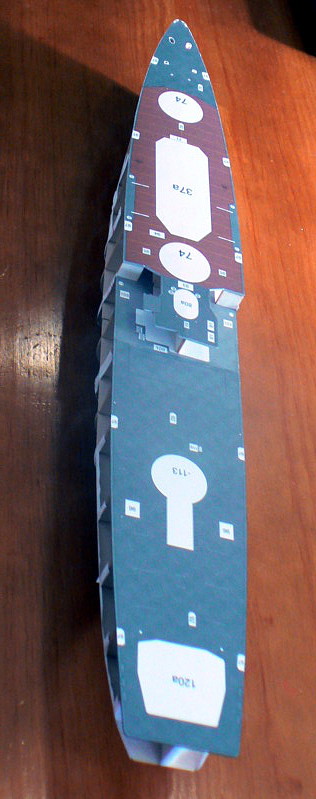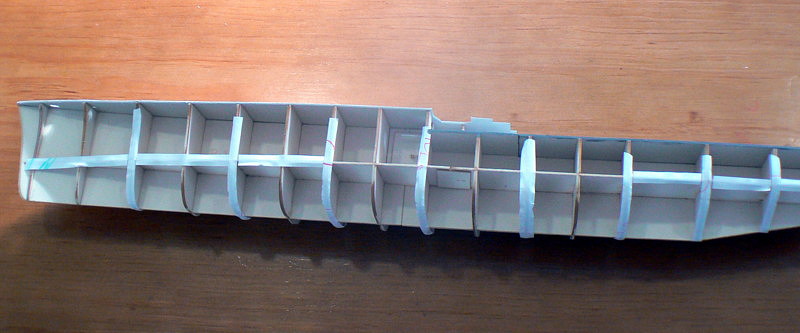Akitsushima; Answer; 1/200
- Thread starter tino
- Start date
You are using an out of date browser. It may not display this or other websites correctly.
You should upgrade or use an alternative browser.
You should upgrade or use an alternative browser.
Yes Zathros, this time I will post build pictures.
Well, after sometime without giving news I am back with the first pictures of the building process.
For now everyting went more or less well.
Well, after sometime without giving news I am back with the first pictures of the building process.
For now everyting went more or less well.
Attachments
JanMarciniak - Thank you for your interest. Finally I have some news from the model. I am with a big lack of time to make paper models...
After almost seven months without bringing news about the model I came here today to show a small advance in the model.
This time I glued the deck. I also glued some paper strips to help me gluing the hull parts.



After almost seven months without bringing news about the model I came here today to show a small advance in the model.
This time I glued the deck. I also glued some paper strips to help me gluing the hull parts.



- Apr 5, 2013
- 13,876
- 10,215
- 228
Those formers look perfect. That is gong to give you an excellent basis to continue on. You wouldn't believe how many people I see start out with crooked formers, then wonder why the side pieces don't fit, or the whole model is twisted. They don't put the sides on at the same time, and the one side drives, pulling the whole model to that direction, or stretch the skins so tight, they get the skeleton effect. You are off with a superb start! 
Thank you.
Zathros - I try to do my best. Well I glue the skin and it all went well.
Only in the stern I needed to make a strip of paper to close the gap because of the short skin. It seems that it is one problem that all modellers have in this model.
Zathros - I try to do my best. Well I glue the skin and it all went well.
Only in the stern I needed to make a strip of paper to close the gap because of the short skin. It seems that it is one problem that all modellers have in this model.
Attachments
- Apr 5, 2013
- 13,876
- 10,215
- 228
These really look like ship subections, just like the real thing. I must congratulate you on your flawless assembly and craftsmanship. 
- Apr 5, 2013
- 13,876
- 10,215
- 228
I'd love to have one of those gun directors mounted to a tower on my property, just to scare off some jerk neighbors!! 
Yes that would be nice zathros!
I have a similar ideia. To have an militar aircraft in my garden. One Fiat G-91 it would fit just well.
Start to put the small details.
They are really small.
I have a similar ideia. To have an militar aircraft in my garden. One Fiat G-91 it would fit just well.
Start to put the small details.
They are really small.
Attachments
- Apr 5, 2013
- 13,876
- 10,215
- 228
Thank you zathros!
It could be better but its not easy to deal with pieces that era so small.
Next I will change "direction" and start with the plane.
It could be better but its not easy to deal with pieces that era so small.
Next I will change "direction" and start with the plane.
- Apr 5, 2013
- 13,876
- 10,215
- 228
A long time ago, when I used to make Destroyers of the U.S. Navy, I, being a machinist, always imagined the relative thickness of the parts I was putting together. This relativity is what turned me off to plastic models. I was also a Mold Maker, and knew the limitations of that process. When making the ship's bridges, and other certain sections, I realized that the catwalk guards had to be made out of normal paper stock. I would stiffen the back side with "Crazy Glue" so they would not warp, and make the railings out of thicker stock, on some models I would roll tubes. I used to paint my models a lot, so "Greebling" was the norm, as was color matching and paintings. This is where plastic ship models fall short, when everything is the same thickness, the models lose depth when scrutinized closely. People don't even know why they would say, "That looks so real", when looking at the paper models, most had no idea of what they were made of. I used everything and anything, so they were really multimedia models.. It's these small details, like cutting out the railings, and using string for them, again, I would dope these with a liquid hardener so they would not sag, though on many ship the wires really do sag a little. Just my two cents worth, and this was for larger scale models. For smaller scale, forgeddaboutit! When I moved on to sailboats, then accuracy became paramount, as I was actively sailing a real 10 meter boat for a few years, and the few people I made models for wanted accuracy, as many of these models where displayed in their homes. I didn't get really any money out of it, but being able to take out a $100,000 dollar sailboat a few times with just me and a girlfriend was payment enough. When it came to repairing boats, fiberglass damage/re-enforcement, changing starter motors/engines, rebuilding winches, etc. I whacked the sh*t out of them (for monetary gain, if you know what I mean  ) .
) . 
- Apr 5, 2013
- 13,876
- 10,215
- 228
If you want some suggestions on planes, let me know. The Dalotel is FREE, but is difficult, but you end up with a miniature airplane, in the sense, that is looks like you miniaturized an airplane. I've only seen one person pull it off. You could because you pay attention to detail. Just a suggestion, I know of many others, let me know the genre you're interested, we also have many here. Bob's Card models has some fantastic ones hosted on this site. 
Link = http://pierreg.free.fr/carton/extra/dalotel/dalotelp1.htm



Link = http://pierreg.free.fr/carton/extra/dalotel/dalotelp1.htm


































